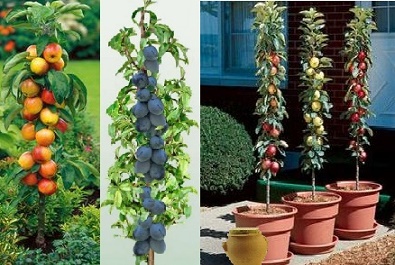Regardles of your yard or gardens’ size, you DO have room for a fruit tree, or two, or three.
When your garden is so tiny that many of your plants are grown in pots cultivating your own fruit might seem ludicrous, but its not. Apples, peaches, cherries, plums, pears, and even some of the more unusual fruits such as custard apples, medlars and persimmons can be accomodated in fairly compact areas. In warmer regions many citrus and sub tropical trees can easily be accomodated in small yards and gardens.
Compact and Ultra-compact varieties are capable of being grown successfully in containers or in tight area by fences, walls or a forgotten corner of your yard. And of course there are many types of dwarf and conmpact fruit trees that be grown in pots inside or out, or a combination thereof. Transporting them out in warm weather and indoors in inclement weather.
Super dwarf or ultra dwarf trees are excellent for tight spaces like balconies. There are only a few choices available in this minute size. They are grown on specialized root stock keeping them from getting larger than 3 to 6 feet tall. They are usually container grown which is why they are an excellent choice for patio and balcony gardens.
Columnar Fruit Trees grow upwards and not out. They do not produce the space consuming side branches that nearly all trees do, but grow in a climbing spire. This ‘columnar’ growth habit not only makes for pleasing eye candy, it saves space enabling those growers with limited land capacity to have productive and attractive fruit laden trees in a small expanse of land. A small yard, balcony, a corner or even a hedgerow can easily accomodate a columnar fruit tree.

Dwarf and Compact Fruit Trees
Size matters
Fruit trees come in four different sizes: Standard, semi-dwarf, dwarf, and less commonly, super-dwarf. This means that you can choose a tree that will fit your space perfectly. When considering the options on the list of fruit trees above, decide which size tree will work best for your space.
Standard fruit trees need a fair amount of space and are a good choice if you’re hoping for high branches that will provide shade.
Choosing a dwarf tree variety will not impact the size of the fruit. A dwarf tree does not mean a smaller apple; it just means that the size of the tree itself (and thus the quantity of fruit) will be reduced.
They’re ideal when growing fruit trees in pots. This is done by grafting various fruit varieties onto a rootstock that produces small trees.
Apples The spread and height of fully mature standard sized apple tree may be ideal for sitting under, just don’t sit under the apple tree with anyone else but me …. Their blossoms are aethetically and aromatically appealing in the spring, they attract pollinators and provide a bountiful harvest come late summer and autumn. Smaller mor compact varieties may not be ideal for sitting under but they do have all the other desirable attributes of aesthetic appeal and tasty, edible harvests year after year.
Crab apples which ARE the same species as standard apples are ideal for many suburban and even rural or urban yards. An apple that’s less than 2 inches round is considered a crab apple. Although crab apples got a bad rep due to the bitter and pithy taste of ornamental varieties commonly grown. See: Edible Crab Apple Varieties
Pears similar requirements to apples, delicate spring blossoms and a tasty fruit. Harvest, late summer.
Peaches Dwarf peach varieties reach up to 10 feet tall, but are generally shorter and more stout. They can be maintained at a more modest height by pruning. A young dwarf peach tree can produce up to 4 bushels of regular-sized fruit within a few years.
Cherries There are non-fruiting ornamental cherry trees, but why bother ? Oh yes – aesthetics, okay so they look nice but don’t produce any fruit – really ? Compact Fruiting varieties are also available.
Mulberries mulberry trees pop up here and there, generally wild ones spread by bird scat. In the summer there are purplish stains beneath them as they grow on roadsides from all the fallen berries squashed and rotting at their base, what a waste. If you’ve never tasted a mulberry, you’ve missed out. They don’t really taste like raspberry or blackberry but they are sweet and earthy. If you have yard birds, chickens, plant one in an area where the fallen fruit can provide fodder for chickens. The rest can go to you and yor family when you harvest them.
Plums Brilliant pink spring blossoms, flowering plum trees are used frequently as a landscape plant. You can have similar beauty plus a great harvest by choosing a fruiting plum. One of my personal favorites is chikasaw plum, a small tree that generally reaches a maximum height and spread of 12 to 15 feet, although it can reach 25 ft if left to its own devices. It is a primitive relative of domesticated plums and is much smaller. Harvest, late spring and summer.
Related: What is A Blue Sausage Fruit Tree?
